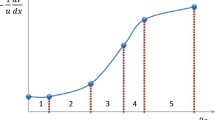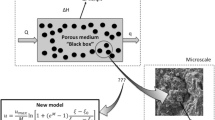Abstract
The most important rheological and mathematical features of the pom–pom model are presently used to compare and improve other constitutive models such as the Giesekus and Phan-Thien–Tanner models. A pragmatic methodology is selected that allows derivation of simple constitutive equations, which are suited to possible software implementation. Alterations to the double convected pom–pom, Phan-Thien–Tanner and Giesekus models are proposed and assessed in rheometric flows by comparing model predictions to experimental data.








Similar content being viewed by others
Notes
Olley (2000) has proposed a modification to the K-BKZ model that combines strain hardening in planar elongational flows with shear thinning.
References
Aguayo JP, Tamaddon-Jahromi HR, Webster MF (2006) Extensional response of the pom–pom model through planar contraction flows for branched polymer melts. J Non Newton Fluid Mech 135:105–126
Bernstein B, Kearsley EA, Zapas LJ (1963) A theory of stress relaxation with finite strain. Trans Soc Rheol 7:391–410
Clemeur N (2004) Simulation, validation and application of a novel melt flow model for highly entangled linear and long chain branched polymers. Ph.D. Thesis, University of Queensland, Brisbane
Clemeur N, Rutgers RPG, Debbaut B (2003) On the evaluation of some differential formulations for the pom–pom constitutive model. Rheol Acta 42(3):217–231
Giesekus H (1982) A simple constitutive equation for polymer fluids based on the concept of deformation dependent tensorial mobility. J Non Newton Fluid Mech 11:69–102
Graham RS, McLeish TCB, Harlen OG (2001) Using the pom–pom equations to analyze polymer melts in exponential shear. J Rheol 45(1):275–290
Hachmann P (1996) Multiaxiale Dehnung von Polymerschmelzen. Ph.D. thesis, Nr. 11890, ETH Zürich
Inkson NJ, McLeish TCB, Harlen OG, Groves DJ (1999) Predicting low density polyethylene melt rheology in elongational and shear flows with “pom–pom” constitutive equations. J Rheol 43(4):873–896
Kaye A (1962) Non-Newtonian flow in incompressible fluids. College of Aeronautics, Note Nr 134
Kraft M (1996) Untersuchungen zur scherinduzierten rheologischen Anisotropie von verschiedenen Polyethylen-Schmelzen. Ph.D. thesis, Nr. 11417, ETH Zürich
Larson RG (1988) Constitutive equations for polymer melts and solutions. Buttherwoths, Boston
Laun HM (1978) Description of the non-linear shear behavior of a low density polyethylene melt by means of an experimentally determined strain dependent memory function. Rheol Acta 17:1–15
McLeish TCB, Larson RG (1998) Molecular constitutive equations for a class of branched polymers: the pom–pom polymer. J Rheol 42(1):81–110
Olley P (2000) An adaptation of the separable KBKZ equation for comparable response in planar and axisymmetric flow. J Non Newton Fluid Mech 95(1):35–53
Phan-Thien N (1978) A nonlinear network viscoelastic model. J Rheol 22(3):259–283
Phan-Thien N, Tanner RI (1977) A new constitutive equation derived from network theory. J Non Newton Fluid Mech 2:353–365
Rubio P, Wagner MH (2000) LDPE melt rheology and the pom–pom model. J Non Newton Fluid Mech 92:245–259
Schleiniger G, Weinacht RJ (1991) A remark on the Giesekus viscoelastic fluid. J Rheol 33:1157–1170
Tanner RI, Nasseri S (2003) Simple constitutive models for linear and branched polymers. J Non Newton Fluid Mech 116:1–17
Tanner RI, Zdilar AM, Nasseri S (2005) Recoil from elongation using general network models. Rheol Acta 44:513–520
van Meerveld J (2002) Note on the thermodynamic consistency of the integral pompom model. J Non Newton Fluid Mech 108(1–3):291–299
Verbeeten WMH (2001) Computational polymer melt rheology. Ph.D. thesis, Technische Universiteit Eindhoven
Verbeeten WMH, Peters GWM, Baaijens FPT (2001) Differential constitutive equations for polymer melts: the eXtended pom–pom model. J Rheol 45(4):823–843
Wagner MH (1976) Analysis of time-dependent non-linear stress-growth data for shear and elongational flow of a low-density branched polyethylene melt. Rheol Acta 15:136–142
Acknowledgement
N. C. acknowledges the financial support from The University of Queensland in the form of a Graduate School Award (UQGSA). N. C. wishes also to thank Dr. Rulande Rutgers from the company Plantic for the fruitful discussions. The authors are also grateful to Fluent, Michelin and SK Chemicals for funding this research.
Author information
Authors and Affiliations
Corresponding author
Appendices
Appendix
Stress equation for the MDCPP model and interpretation
Although this may bring the reader somewhat beyond the scope of the present paper, it can be instructive to derive the constitutive equation written in terms of extra-stress tensor for one of the suggested models. Presently, we select the MDCPP model as a candidate for this exercise. For this, let us define Σ as follows:
so that T can be rewritten as
In a few words, the methodology for obtaining the equation for Σ consists, at first, of using Eq. 6 for substituting S as a function of Σ and Λ in Eq. 18 in Table 3, and for substituting Λ as a function of tr(Σ). The subsequent part consists of a careful rewriting of the equation. Eventually, after appropriate simplifications, the constitutive equation for the MDCPP model can be written as a function of Σ as follows:
where the quantity E is given by:
From Eq. 8, one can attempt to connect the MDCPP model to the general network theory. Following the guidelines suggested, e.g. by Tanner and Nasseri (2003), we successively identify in Eq. 8 a transport of junctions, a rate of destruction of junctions and a rate of creation of junctions. The function controlling the rate of destruction of junctions is given by the coefficient of the second term on the left-hand side of Eq. 8. Since it is a rate, it has the dimension of a reciprocal time. Similarly, the function governing the rate of creation of junctions is given by the coefficient of I on the right-hand side of Eq. 8; here too, this function has the dimension of a reciprocal time.
A constitutive equation written in terms of Σ (or of extra-stress tensor T) can be of interest from the point of view of the general network theory. However, the corresponding form written as a function of orientation tensor S and stretching variable Λ allows an easier qualitative interpretation of the various mechanisms involved and undergone by the macromolecules of a polymer melt.
Rights and permissions
About this article
Cite this article
Clemeur, N., Debbaut, B. A pragmatic approach for deriving constitutive equations endowed with pom–pom attributes. Rheol Acta 46, 1187–1196 (2007). https://doi.org/10.1007/s00397-007-0203-x
Received:
Accepted:
Published:
Issue Date:
DOI: https://doi.org/10.1007/s00397-007-0203-x




